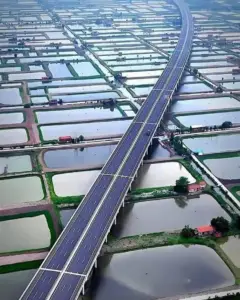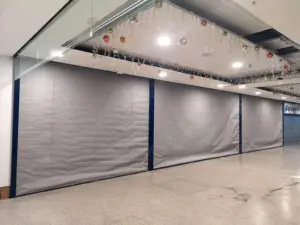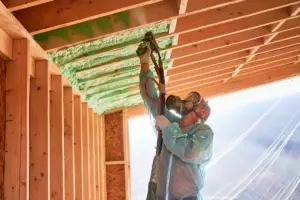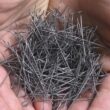We know that soil or any other loose granular material has a safe angle of repose at which the soil or material can withstand without any requirement of confinement or support. But due to practical and property restrictions we in some cases need to cut or fill the soil at some unstable angle which if unsupported might cause failure of the slope.
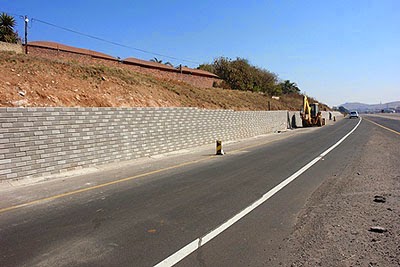 |
| Concrete Retaining Wall |
If we provide stable slope rather than steep slope; we might need more space there and sometimes more economy is required; to cater this problem we use the retaining wall to support the material laterally after justifying its usage from economic considerations.
Thus we can define retaining wall;
What is Retaining Wall?
As a structure or a part of structure that holds back and retained the loose material behind within a limited space to provide safety and economy one at the same end.
Or
McCormac and Nelson defines it as;
Retaining wall is a structure built for the purpose of holding back or retaining or providing one-sided lateral confinement of soil or other loose material.
Aurther H. Nilson and others define the retaining wall as;
Retaining walls are used to hold back masses of earth or other loose material where conditions make it impossible to let those masses assume their natural slopes.
Example Of Retaining Wall
Typical example of the retaining wall might be that of highways; in highways we have restricted property space called the right-of-way and within that limited space we have to provide the required width of the highway by using the cut and fill soil, and there those steep slopes come which needs retaining wall to get that support;
Types of Retaining Walls
Most commonly five types of retaining walls are used named as under;
(a) Gravity Retaining wall
(b) Cantilever Retaining Wall
(c) Counter-fort Retaining wall
(d) Buttress Retaining wall
(e) Bridge-abutment type retaining wall
Gravity Retaining Wall;
The Gravity Retaining wall as the name suggests provide support or restraint to the loose material laterally because of its self-weight, it generally doesn’t contain reinforcement and mostly is used for 10 ft height and no more than that because more height will increase the need of more thicker cross-section and ultimately it will not be economical.
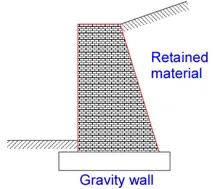 |
| Gravity Type Retaining Wall |
Cantilever Retaining Wall
Is a reinforced retaining wall that acts like a cantilever beam, it has four parts, the portion of the base slab or footing below the retained material is heel, and the other portion is toe, the vertical wall is called stem and to increase the slide friction key is provided below the base slab or footing.
The weight of the retained soil on the top of heel provides additional stability to the structure. It is mostly used for relatively greater heights upto 10 to 20 ft.
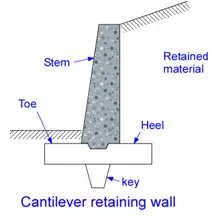 |
| Cantilever Type Retaining Wall |
Counter-fort Retaining Wall
In Counter-fort retaining wall the stem and heel (the portion of the base slab below the retained slow) are joined together by inclined transverse walls at intervals called counterforts, Counterforts are in tension and mostly called counterfort ties. Counterfort retaining wall is mostly used for higher heights up to 25ft or more.
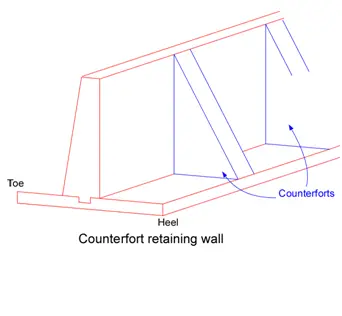 |
| Counter Fort Retaining Wall |
Buttress Retaining Wall
Buttress retaining wall is similar to counterfort retaining wall except that the inclined transverse walls are provided at the front of the stem called buttresses and acts like a compression member. Because of this property they are more stable and more economical, but because the buttresses are visible and occupies the space un-necessarily that might be useful if buttresses were not there; thus they are not generally used;
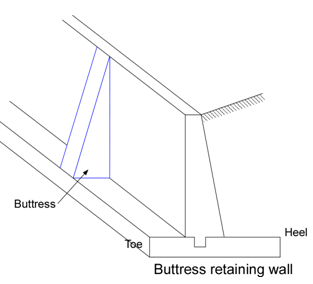 |
| Buttress Retaining Wall |
Bridge Abutment Retaining Wall
It is a wall types bridge abutment, abutment and piers are the column-type structures used to support the deck of the bridge, the first and the last support of the bridge are called abutments because they retains the soil where as other supports are called piers. This type of retaining wall is just a simple cantilever retaining wall except that the bridge deck provides an additional horizontal restraint at the top of the stem. This wall is thus designed as a beam with fixed support at the bottom and simply supported or partially restrained at the top.
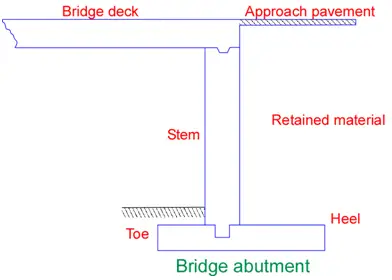 |
| Bridge Abutment Retaining Wall |
From Editor’s Desk
Retaining Walls are very sensitive type of structures that protects our infrastructure like highways and roads from land-slides etc and helps us to let the roads be clear for us. In the retaining wall drain pipes are also provided along with pot-holes for reducing the amount of lateral load and to allow the wall to remain stable against overturning and sliding.
Hope you like this post, don’t forget to share it with your friends and colleagues.
Happy Civil Engineering!
Keywords for Retaining Walls
types of retaining walls
retaining walls cost
concrete retaining walls
retaining walls garden
retaining walls construction
building retaining walls
retaining walls diy
retaining walls design








